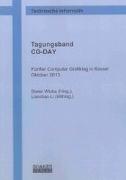- Start
- Tagungsband CG-DAY
Tagungsband CG-DAY
Angebote / Angebote:
This thesis presents an approach for analyzing construction operations with micro tunnel boring machines (MTBM) utilizing process simulation. The goal is to develop an appropriate and adaptable simulation module for microtunnelling construction operations. It helps to analyze the processes and to identify the factors, which influence the operation productivity of the construction process essentially. In addition, the influence of different soil conditions and of disturbances on the productivity of microtunnelling operations have to be determined. In view of these objectives, a System Modeling Language (SysML) model describing the microtunnelling process is developed in the first step. The simulation model consists of three types of diagram: block definition diagram (bdd), state machine diagram (stm) and sequence diagram (sd), which are supported in the SysML. The simulation model is used to analyze and understand the entire process involved in microtunnelling construction and identify the model variables for which information needs to be collected. Subsequently, the simulation software AnyLogic is applied to create the MiSAS (Microtunnelling: Statistics, Analysis and Simulation) simulation module based on the SysML formalization. The implementation of the proposed methodologies, utilizes discrete event simulation (DES) and system dynamic (SD) modelling. Three actual microtunnelling projects at the city of Recklinghausen, Germany, are used for the validation of the developed simulation module. After validation, the simulation module is expanded with considerations of different soil compositions and disturbances of operations. The simulation module allows to evaluate the impact of the different ground conditions, disturbances and predict the resulting tunnel advance rate. Further, the impact of varying resources on the MTBM advance rate is studied in a sensitivity analysis.
During the conference, ten presentations were given. In this proceedings, the associated contributions are printed.
The first presentation introduced the "3D Multi View Technology" and how to create auto-stereoscopic display on future TVs. Then the "Feuerwehr-Trainingssimulation" with regards to NPC control and game analysis was presented, which also explained how to develop NPC behaviour with the help of an expert system. Afterwards the 3D city model of Kassel was presented, including explanations about the methods of modeling the architecture. The next presentation was titled "Real-Time Fire Simulation", here the algorithm and the data structure design for realtime fires were presented and the result was shown via video demo. The fifth presentation was "Das historische Kassel in 3D", which illustrated a historical city model of Kassel from the early 20 th century and explained the way of how photos and maps were used to model it. Then the "planning technologies", a critical part of an AI system, were presented together with the demonstration of the corresponding video games. The next talk was about how to use different sensors on real devices as control methods for virtual reality applications to make people feel more immersive. Then the analysis of how to evaluate educational games was introduced. The algorithm of "Realtime simulation of a water surface" was presented afterwards and a demonstration of its use in an application was given on a tablet device. The final presentation introduced an algorithm of the "Vision system" for NPCs in virtual environments.
Libri-Titel folgt in ca. 2 Arbeitstagen
